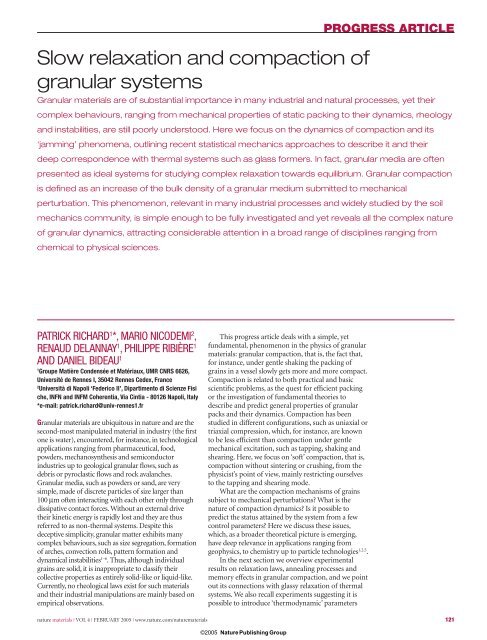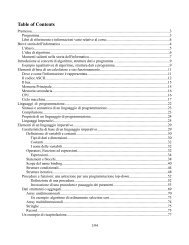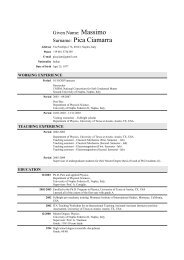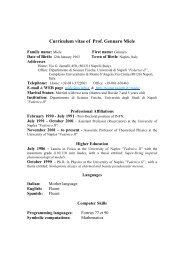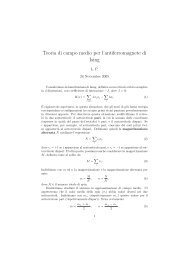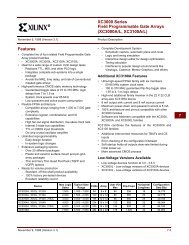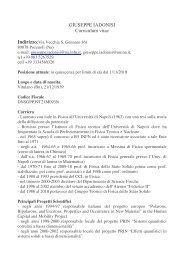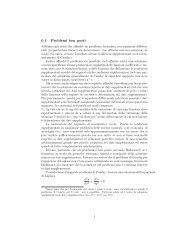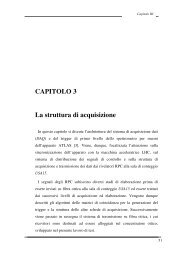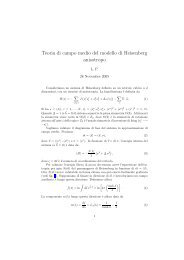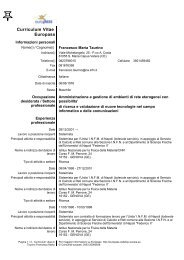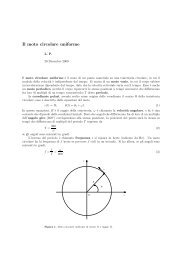Slow relaxation and compaction of granular systems
Slow relaxation and compaction of granular systems
Slow relaxation and compaction of granular systems
Create successful ePaper yourself
Turn your PDF publications into a flip-book with our unique Google optimized e-Paper software.
<strong>Slow</strong> <strong>relaxation</strong> <strong>and</strong> <strong>compaction</strong> <strong>of</strong><br />
<strong>granular</strong> <strong>systems</strong><br />
PROGRESS ARTICLE<br />
Granular materials are <strong>of</strong> substantial importance in many industrial <strong>and</strong> natural processes, yet their<br />
complex behaviours, ranging from mechanical properties <strong>of</strong> static packing to their dynamics, rheology<br />
<strong>and</strong> instabilities, are still poorly understood. Here we focus on the dynamics <strong>of</strong> <strong>compaction</strong> <strong>and</strong> its<br />
‘jamming’ phenomena, outlining recent statistical mechanics approaches to describe it <strong>and</strong> their<br />
deep correspondence with thermal <strong>systems</strong> such as glass formers. In fact, <strong>granular</strong> media are <strong>of</strong>ten<br />
presented as ideal <strong>systems</strong> for studying complex <strong>relaxation</strong> towards equilibrium. Granular <strong>compaction</strong><br />
is defi ned as an increase <strong>of</strong> the bulk density <strong>of</strong> a <strong>granular</strong> medium submitted to mechanical<br />
perturbation. This phenomenon, relevant in many industrial processes <strong>and</strong> widely studied by the soil<br />
mechanics community, is simple enough to be fully investigated <strong>and</strong> yet reveals all the complex nature<br />
<strong>of</strong> <strong>granular</strong> dynamics, attracting considerable attention in a broad range <strong>of</strong> disciplines ranging from<br />
chemical to physical sciences.<br />
PATRICK RICHARD 1 *, MARIO NICODEMI 2 ,<br />
RENAUD DELANNAY 1 , PHILIPPE RIBIÈRE 1<br />
AND DANIEL BIDEAU 1<br />
1 Groupe Matière Condensée et Matériaux, UMR CNRS 6626,<br />
Université de Rennes I, 35042 Rennes Cedex, France<br />
2 Università di Napoli ‘Federico II’, Dipartimento di Scienze Fisi<br />
che, INFN <strong>and</strong> INFM Coherentia, Via Cintia - 80126 Napoli, Italy<br />
*e-mail: patrick.richard@univ-rennes1.fr<br />
Granular materials are ubiquitous in nature <strong>and</strong> are the<br />
second-most manipulated material in industry (the fi rst<br />
one is water), encountered, for instance, in technological<br />
applications ranging from pharmaceutical, food,<br />
powders, mechanosynthesis <strong>and</strong> semiconductor<br />
industries up to geological <strong>granular</strong> fl ows, such as<br />
debris or pyroclastic fl ows <strong>and</strong> rock avalanches.<br />
Granular media, such as powders or s<strong>and</strong>, are very<br />
simple, made <strong>of</strong> discrete particles <strong>of</strong> size larger than<br />
100 µm <strong>of</strong>ten interacting with each other only through<br />
dissipative contact forces. Without an external drive<br />
their kinetic energy is rapidly lost <strong>and</strong> they are thus<br />
referred to as non-thermal <strong>systems</strong>. Despite this<br />
deceptive simplicity, <strong>granular</strong> matter exhibits many<br />
complex behaviours, such as size segregation, formation<br />
<strong>of</strong> arches, convection rolls, pattern formation <strong>and</strong><br />
dynamical instabilities 1–6 . Thus, although individual<br />
grains are solid, it is inappropriate to classify their<br />
collective properties as entirely solid-like or liquid-like.<br />
Currently, no rheological laws exist for such materials<br />
<strong>and</strong> their industrial manipulations are mainly based on<br />
empirical observations.<br />
This progress article deals with a simple, yet<br />
fundamental, phenomenon in the physics <strong>of</strong> <strong>granular</strong><br />
materials: <strong>granular</strong> <strong>compaction</strong>, that is, the fact that,<br />
for instance, under gentle shaking the packing <strong>of</strong><br />
grains in a vessel slowly gets more <strong>and</strong> more compact.<br />
Compaction is related to both practical <strong>and</strong> basic<br />
scientifi c problems, as the quest for effi cient packing<br />
or the investigation <strong>of</strong> fundamental theories to<br />
describe <strong>and</strong> predict general properties <strong>of</strong> <strong>granular</strong><br />
packs <strong>and</strong> their dynamics. Compaction has been<br />
studied in different confi gurations, such as uniaxial or<br />
triaxial compression, which, for instance, are known<br />
to be less effi cient than <strong>compaction</strong> under gentle<br />
mechanical excitation, such as tapping, shaking <strong>and</strong><br />
shearing. Here, we focus on ‘s<strong>of</strong>t’ <strong>compaction</strong>, that is,<br />
<strong>compaction</strong> without sintering or crushing, from the<br />
physicist’s point <strong>of</strong> view, mainly restricting ourselves<br />
to the tapping <strong>and</strong> shearing mode.<br />
What are the <strong>compaction</strong> mechanisms <strong>of</strong> grains<br />
subject to mechanical perturbations? What is the<br />
nature <strong>of</strong> <strong>compaction</strong> dynamics? Is it possible to<br />
predict the status attained by the system from a few<br />
control parameters? Here we discuss these issues,<br />
which, as a broader theoretical picture is emerging,<br />
have deep relevance in applications ranging from<br />
geophysics, to chemistry up to particle technologies 1,2,5 .<br />
In the next section we overview experimental<br />
results on <strong>relaxation</strong> laws, annealing processes <strong>and</strong><br />
memory effects in <strong>granular</strong> <strong>compaction</strong>, <strong>and</strong> we point<br />
out its connections with glassy <strong>relaxation</strong> <strong>of</strong> thermal<br />
<strong>systems</strong>. We also recall experiments suggesting it is<br />
possible to introduce ‘thermodynamic’ parameters<br />
nature materials | VOL 4 | FEBRUARY 2005 | www.nature.com/naturematerials 121<br />
© 2005<br />
Nature Publishing Group
PROGRESS ARTICLE<br />
Figure 1 Experimental set-ups<br />
<strong>and</strong> density <strong>relaxation</strong> laws.<br />
a, Set-up for the experiments<br />
carried out in Chicago.<br />
The numbers 1–4 refer to<br />
capacitors used to measure<br />
the packing density (see<br />
ref. 9). b, Typical evolution<br />
<strong>of</strong> the packing fraction as<br />
a function <strong>of</strong> the number <strong>of</strong><br />
taps, t, for experiments in<br />
Chicago for different values<br />
<strong>of</strong> the acceleration amplitude.<br />
Superimposed lines are<br />
logarithmic fi ts with equation<br />
(1). Each curve is an average<br />
<strong>of</strong> four to fi ve separate runs,<br />
<strong>and</strong> the error bars represent<br />
the r.m.s. variation between<br />
runs (for clarity, just a few error<br />
bars are reported). c, Set-up<br />
for the experiments carried out<br />
in Rennes. d, Typical evolution<br />
<strong>of</strong> the packing fraction for the<br />
experiments in Rennes. Here<br />
dashed lines are stretched<br />
exponential fi ts with equation<br />
(2). Parts a <strong>and</strong> b reprinted<br />
with permission from ref. 9.<br />
Copyright (1995) by the<br />
American Physical Society.<br />
a Vacuum<br />
b<br />
to describe the status <strong>of</strong> the system. In the following<br />
section we briefl y discuss theoretical models <strong>of</strong><br />
<strong>compaction</strong> <strong>and</strong> Edwards’ extension <strong>of</strong> statistical<br />
mechanics to <strong>granular</strong> media 7,8 . In this framework,<br />
we discuss current theories about the glassy phase <strong>of</strong><br />
<strong>granular</strong> media <strong>and</strong> their deep connections to thermal<br />
glass formers. In the last section we will try to outline<br />
some <strong>of</strong> the open questions ahead.<br />
EXPERIMENTAL RESULTS ON GRANULAR COMPACTION<br />
DENSITY RELAXATION LAWS<br />
1<br />
2<br />
3<br />
4<br />
Nitrogen<br />
c d<br />
The fi rst quantity <strong>of</strong> interest in <strong>compaction</strong> is the<br />
packing fraction (or density) ρ, defi ned as the ratio <strong>of</strong><br />
the volume <strong>of</strong> the grains to the total volume occupied by<br />
the packing. A few characteristic values <strong>of</strong> ρ for monosized<br />
sphere packings have to be noted. The maximal<br />
packing fraction achieved in a r<strong>and</strong>om packing <strong>of</strong><br />
spheres (the so-called r<strong>and</strong>om close-packing fraction)<br />
is ρ RCP ≈ 0.64. This value is signifi cantly lower than the<br />
maximal packing fraction obtained for face-centredcubic<br />
(or hexagonal compact) packing (ρ max ≈ 0.74).<br />
Another limit is the so-called r<strong>and</strong>om loose packing<br />
corresponding to a mechanically stable packing with the<br />
lowest packing fraction (ρ RLP ≈ 0.55).<br />
In a pioneer paper, Knight et al. 9 in Chicago<br />
fi rst considered density <strong>relaxation</strong> laws in<br />
Γ<br />
<strong>granular</strong> <strong>compaction</strong>. They recorded that, starting<br />
from a loose packing <strong>of</strong> beads confi ned in a very thin<br />
<strong>and</strong> tall tube (diameter 1.88 cm <strong>and</strong> 87 cm height,<br />
see Fig. 1a), a succession <strong>of</strong> vertical taps induces a<br />
progressive <strong>and</strong> very slow <strong>compaction</strong> <strong>of</strong> the system.<br />
They observed (see Fig. 1b) that the <strong>relaxation</strong> law<br />
can be well fi tted by an inverse-logarithmic law, the<br />
so-called Chicago fi t (resembling ‘magnetic creep’ <strong>of</strong><br />
type-II supercondutors):<br />
ρ(t) = ρf –<br />
ρ0 – ρf 1+B ln(1+t/τ)<br />
The only control parameter for the dynamics<br />
was found to be the ratio Γ = a/g <strong>of</strong> the tap peak<br />
acceleration <strong>and</strong> gravity acceleration, that is, the<br />
fi tting parameters: ρ f the fi nal packing fraction, ρ 0 the<br />
initial packing fraction, τ a characterisitc time, <strong>and</strong> B<br />
a fi tting paramater, essentially depend on Γ. The small<br />
number <strong>of</strong> grains in a tube diameter (≈ 10) allows<br />
a local measurement <strong>of</strong> the packing fraction with a<br />
capacitive method <strong>and</strong> prevents any convection in<br />
the packing. Nevertheless, it induces strong boundary<br />
effects that may be responsible for crystallization<br />
(some packing-fraction values obtained are well above<br />
the r<strong>and</strong>om close-packing limit) visible in some <strong>of</strong> the<br />
Chicago group’s experiments 10 <strong>and</strong> in the values <strong>of</strong> ρ f<br />
obtained in ref. 9.<br />
122 nature materials | VOL 4 | FEBRUARY 2005 | www.nature.com/naturematerials<br />
ρ<br />
ρ<br />
© 2005<br />
Nature Publishing Group<br />
0.64<br />
0.62<br />
0.60<br />
0.58<br />
0.63<br />
0.62<br />
0.61<br />
0.60<br />
0.59<br />
0.58<br />
× 1.4<br />
1.8<br />
2.3<br />
2.7<br />
3.1<br />
4.5<br />
+ 5.4<br />
10 10 1 10 2 10 3 10 4<br />
Γ = 3.15<br />
t + 1<br />
Γ = 1.60<br />
Γ = 1.16<br />
Γ = 0.96<br />
10 10 1 10 2 10 3 10 4 10 5<br />
t + 1<br />
(1)
0.65<br />
0.64<br />
0.63<br />
0.62<br />
0.61<br />
0.6<br />
0.59<br />
0 1 2 3 4 5 6 7<br />
Γ<br />
More recently, Philippe <strong>and</strong> Bideau 11 carried out<br />
<strong>compaction</strong> experiments; in the following we will<br />
refer to these as the Rennes group’s experiments.<br />
The vessel used is a 10-cm-diameter cylinder <strong>and</strong><br />
1-mm-diameter glass beads, which leads to 100<br />
grains between the side walls. This restricts the<br />
boundary effects but, contrary to the Chicago group’s<br />
experiments, allows convection. The packing fraction<br />
is measured using a γ-ray absorption set-up 11 . The<br />
<strong>relaxation</strong> laws obtained by these authors differ<br />
signifi cantly from those obtained by Knight et al. 9 ,<br />
especially for the long-time behaviour. Indeed,<br />
whereas in previous experiments no clear steadystate<br />
was reached, this is defi nitely established in<br />
Rennes group’s experiments, <strong>and</strong> may correspond<br />
to a dynamical balance between convection <strong>and</strong><br />
<strong>compaction</strong>. The <strong>relaxation</strong> is better fi tted by the<br />
Kohlrausch–Williams–Watts law (KWW law) — a<br />
stretched exponential:<br />
ρ(t) = ρ f – (ρ f – ρ 0) exp[–(t/τ) β ] (2)<br />
where ρ f <strong>and</strong> ρ 0 correspond respectively to the<br />
steady-state <strong>and</strong> to the initial packing-fraction value.<br />
The adjustable parameters τ <strong>and</strong> β correspond here<br />
respectively to the <strong>relaxation</strong> time <strong>and</strong> to the stretching<br />
<strong>of</strong> the exponential. This characteristic timescale is found<br />
to be well described by an Arrhenius behaviour τ = τ 0<br />
exp [Γ 0/Γ]. Such a <strong>relaxation</strong> law is also found for strong<br />
glasses (the dimensionless acceleration Γ plays the role<br />
<strong>of</strong> the temperature).<br />
Another quantity <strong>of</strong> interest is the fi nal packing<br />
fraction obtained by the fi t: ρ f. Here again there<br />
exists a strong discrepancy between the Chicago<br />
group’s experiments <strong>and</strong> the Rennes group’s work.<br />
In the former case this packing fraction is found to<br />
increase with the tapping intensity, Γ, whereas it is<br />
found to decrease in the latter. These discrepancies<br />
are related to the fact that the Chicago experiments<br />
are performed in a region where the system is far<br />
from stationary, whereas the Rennes experiments are<br />
focusing on the stationary regime. This is likely to<br />
originate from the difference <strong>of</strong> confi nement between<br />
the two experiments. Indeed, for the Chicago group’s<br />
work, the strong boundary effects lead to order<br />
ρ<br />
creation at least close to the side walls <strong>and</strong> to packing<br />
fractions higher than 0.64. On the contrary, all the<br />
fi nal packing fractions obtained for glass beads <strong>and</strong><br />
with a very low confi nement by the Rennes group<br />
are below this value. Nevertheless, these results are<br />
affected by convection. Indeed, a signifi cant change<br />
is observed in the dependence <strong>of</strong> ρ f on Γ, which<br />
might correspond to different convective regimes 11,12 .<br />
Under a threshold Γ c ≈ 2, the fi nal state <strong>of</strong> the free<br />
surface <strong>of</strong> the packing is an inclined<br />
plane <strong>and</strong> indicates a spontaneous breaking <strong>of</strong><br />
symmetry. Above this value, the free surface takes a<br />
fl at conical shape.<br />
It should be pointed out that all the studies<br />
reviewed above deal with isotropic <strong>granular</strong><br />
media. Of course, most actual <strong>granular</strong> materials<br />
are far from being isotropic, <strong>and</strong> the grain shape<br />
may modify the behaviour <strong>of</strong> the system during<br />
<strong>compaction</strong>. Villarruel et al. 13 have shown, using<br />
a Chicago set-up, that a nematic ordering can be<br />
observed for <strong>compaction</strong> <strong>of</strong> rods. Ribière et al.<br />
(ref. 14, <strong>and</strong> ibid, manuscript in preparation) carried<br />
out experiments <strong>of</strong> <strong>compaction</strong> <strong>of</strong> rice with the<br />
set-up in Rennes (low confi nement). They did not<br />
observe such an ordering <strong>and</strong> obtained <strong>compaction</strong><br />
characteristics similar to those obtained with glass<br />
beads. Note that the aspect ratio <strong>of</strong> the grains is<br />
probably an important parameter <strong>of</strong> the problem.<br />
ANNEALING AND MEMORY EFFECTS<br />
Further insight into the underst<strong>and</strong>ing <strong>of</strong> the nature<br />
<strong>of</strong> the <strong>relaxation</strong> can be gained by allowing the tap<br />
intensity to vary in time. Nowak et al. 10,15 (<strong>and</strong> later<br />
Philippe 16 with the Rennes set-up) have reported<br />
annealing experiments. Using the Chicago set-up they<br />
proceeded as follows: starting from a loose packing <strong>of</strong><br />
grains, the material is tapped at a given intensity Γ for<br />
a given time t (10 5 taps). Γ is then modifi ed <strong>and</strong> the<br />
<strong>compaction</strong> process continued for t taps (see Fig. 2a).<br />
The increase <strong>of</strong> Γ corresponds to an increase <strong>of</strong> the<br />
average packing fraction except for values larger than<br />
three for which a slow decrease can be observed. This<br />
slow decrease can be interpreted as void creation<br />
due to a too-large agitation. If Γ is then reduced, the<br />
PROGRESS ARTICLE<br />
0.66<br />
a b Figure 2 Annealing <strong>and</strong><br />
ρ<br />
Reversible<br />
Irreversible<br />
Increasing<br />
Decreasing<br />
Increasing again<br />
0.62<br />
0.615<br />
0.61<br />
–10 0 10 20 30 40 50<br />
t–t 0<br />
aging during <strong>compaction</strong>.<br />
a, Annealing curve. The initial<br />
packing was prepared in a<br />
low-density initial confi guration<br />
(ρ ≈ 0.59) <strong>and</strong> then the<br />
acceleration amplitude Γ was<br />
slowly fi rst increased (solid<br />
circles) <strong>and</strong> then decreased<br />
(open circles). At each value<br />
<strong>of</strong> Γ the system was tapped<br />
10 5 times <strong>and</strong> Γ incremented<br />
by ΔΓ ≈ 0.5. The higher<br />
density branch (the upper<br />
one) is reversible to changes<br />
in Γ (see square symbols).<br />
Each curve is an average <strong>of</strong><br />
separate experimental runs<br />
<strong>and</strong> the error bars represent<br />
the r.m.s. variations between<br />
runs. Reprinted from ref. 10,<br />
Copyright (1997), with<br />
permission from Elsevier.<br />
b, Time evolution <strong>of</strong> packing<br />
fraction for a system that was<br />
compacted to ρ 0 = 0.613 at<br />
time t 0 using three different<br />
accelerations: Γ 1 = 1.8 (circles),<br />
Γ 0 = 4.2 (triangles) <strong>and</strong><br />
Γ 2 = 6.3 (diamonds).<br />
After the packing fraction<br />
ρ 0 was achieved (t = 0),<br />
the system was vibrated at<br />
acceleration Γ 0. The evolution<br />
for t > t 0 depended strongly<br />
on the previous history.<br />
Reprinted from ref. 18.<br />
Copyright (2000) by the<br />
American Physical Society.<br />
nature materials | VOL 4 | FEBRUARY 2005 | www.nature.com/naturematerials 123<br />
© 2005<br />
Nature Publishing Group
E<br />
We have seen that despite the fact that <strong>granular</strong><br />
media may form crystalline packings, in most cases<br />
they are found at rest in disordered confi gurations,<br />
<strong>and</strong> when gently shaken, they exhibit a strong<br />
form <strong>of</strong> ‘jamming’ 9–11,15,19 (that is, an exceedingly<br />
slow dynamics) with deep connections to ‘freezing’<br />
phenomena observed in thermal <strong>systems</strong> such as glass<br />
formers 21–23 . These observations suggested the idea <strong>of</strong><br />
a unifi ed description <strong>of</strong> ‘jamming’ in these different<br />
<strong>systems</strong> 22,24 , whose precise nature is an important<br />
issue that is currently being debated 6 . To face these<br />
topics, it’s necessary to solve another basic conceptual<br />
open problem, that is, the absence <strong>of</strong> an established<br />
theoretical framework to describe <strong>granular</strong> media.<br />
Edwards 7,8,25 proposed a statistical mechanics solution<br />
to such a problem for compact (that is, not ‘fl uidized’)<br />
<strong>granular</strong> <strong>systems</strong> by introducing the hypothesis that<br />
time averages <strong>of</strong> a system, exploring its mechanically<br />
stable states subject to some external drive (for<br />
example, ‘tapping’), coincide with suitable ensemble<br />
averages over its ‘jammed states’ (see Box 2).<br />
∆E 2<br />
∆E 2<br />
EFFECTIVE TEMPERATURES FROM FLUCTUATION–DISSIPATION<br />
RELATIONS<br />
Interestingly, models <strong>of</strong> grain assemblies subject to<br />
a drive (that is, tap or shear) were also used to test<br />
Edwards’ statistical mechanics approach 31,33–36,38–44 .<br />
In recent developments <strong>of</strong> glassy theory 45 , a notion <strong>of</strong><br />
‘effective dynamical temperature’ can be introduced 46 ,<br />
based on the out-<strong>of</strong>-equilibrium extension <strong>of</strong> the<br />
fl uctuation–dissipation theorem 47 (see Box 1).<br />
In <strong>granular</strong> media the ‘glassy’ region can be entered<br />
in the limit <strong>of</strong> very small ‘shaking’ amplitudes, that<br />
is, by letting the system age in contact with an almost<br />
zero bath temperature, T bath. In this way, an effective<br />
temperature, T dyn (see Box 1), was measured in a<br />
model for <strong>granular</strong> media 38 . In particular, within<br />
lattice gas ‘glassy’ <strong>systems</strong>, Barrat et al. 44,48 showed<br />
that the analogue <strong>of</strong> Edwards ‘confi gurational<br />
temperature’, T conf (see Box 2), can be computed<br />
<strong>and</strong>, in the limit T bath → 0, it exhibits a very good<br />
agreement with T dyn. The link between this dynamical<br />
PROGRESS ARTICLE<br />
whole is submitted to vertical continuous vibrations<br />
at the frequency fs (50 Hz < fs < 371 Hz) or to vertical<br />
taps. The perturbation intensity is measured using<br />
an accelerometer as the peak acceleration intensity<br />
normalized to the acceleration gravity Γ = a/g.<br />
To characterize the dynamics <strong>of</strong> the <strong>granular</strong> media<br />
the authors measure optically the motion <strong>of</strong> an<br />
oscillator (eventually submitted to an external torque)<br />
immersed in the media. The motion <strong>of</strong> this oscillator<br />
refl ects, at least partially, the dynamical behaviour<br />
<strong>of</strong> the packing. The study <strong>of</strong> its power spectrum<br />
(<strong>and</strong> thus <strong>of</strong> the diffusivity) shows that the partially<br />
fl uidized <strong>granular</strong> material displays a critical slowdown<br />
from a fl uid state to a glassy state where — as for<br />
supercooled liquid — the diffusivity approaches<br />
zero19 MODELS FOR THE DYNAMICS OF COMPACTION<br />
Before discussing Edwards’ approach, it is interesting<br />
to mention that the slow <strong>compaction</strong> dynamics can<br />
be described by free-volume arguments as processes<br />
where a grain can jump into a hole in the pack only if<br />
the hole is empty. Mean-fi eld-like dynamical models<br />
emphasizing these ‘geometric frustration’ mechanisms<br />
appear indeed to capture the essence <strong>of</strong> the<br />
dynamics<br />
. The authors used the same set-up to try to<br />
defi ne the equivalent <strong>of</strong> a temperature in this system.<br />
The fl uctuation–dissipation theorem (see Box 1)<br />
allowed them to introduce an acceleration-dependent<br />
‘effective temperature’ with the correct properties<br />
<strong>of</strong> a thermodynamic parameter (see Fig. 3b). In this<br />
respect, a quantitative analogy with thermal <strong>systems</strong>,<br />
such as glasses, appears, as further confi rmed by the<br />
observations reported above.<br />
THEORETICAL MODELS<br />
26,27 . Schematic lattice models <strong>of</strong> hard grains<br />
under gravity were introduced to describe dynamical<br />
<strong>and</strong> stationary properties <strong>of</strong> <strong>granular</strong> assemblies in<br />
further detail22,28,29 . Numerical simulations <strong>of</strong> lattice<br />
models21,30–35 <strong>and</strong> parking-lot models27,36,37 show slow<br />
<strong>compaction</strong> dynamics. In the region <strong>of</strong> large tap<br />
amplitudes, the system density as a function <strong>of</strong> the<br />
number <strong>of</strong> shakes can be well fi tted by exponentials.<br />
In the region <strong>of</strong> small tap amplitudes, the system<br />
gets ‘jammed’ <strong>and</strong> ‘memory’ <strong>and</strong> ‘aging’ phenomena<br />
are observed, along with ‘annealing’ effects as those<br />
described in previous experiments9,10,15 . In this region,<br />
stationarity is typically not reached <strong>and</strong> logarithmic<br />
<strong>relaxation</strong> is found21,27 . Correspondingly, the system<br />
<strong>relaxation</strong> time diverges approximately as an<br />
Arrhenius law21 , resembling experimental results11,19 2.4<br />
2.2<br />
2.0<br />
1.2<br />
1.8<br />
0.6<br />
1.6<br />
0.0<br />
5 2 2<br />
1.4<br />
10 2 5<br />
2<br />
,<br />
as the grains’ diffusion coeffi cient goes to zero.<br />
0 5 101 101 100 a<br />
τ0 = 5<br />
τ0 = 10<br />
τ0 = 500<br />
b<br />
1.6 τ0 = 5<br />
τ0 = 10<br />
τ0 = 500<br />
Ensemble average<br />
Figure 4 Temperature<br />
determination in a numerical<br />
model. a, The time average <strong>of</strong><br />
the energy, E<br />
0.8<br />
2.5<br />
2.0<br />
1.5<br />
1.0<br />
5<br />
5<br />
0.5<br />
0.0<br />
0 1 2 3 4 5<br />
TГ TГ TГ 5<br />
0.0<br />
1.4 2.0<br />
E<br />
2.6<br />
– , <strong>and</strong> (inset) its<br />
fl uctuations, – 2 ΔE , recorded<br />
at stationarity during tap<br />
dynamics, as a function <strong>of</strong><br />
the tap amplitude, TΓ, in a<br />
three-dimensional lattice<br />
monodisperse hard-sphere<br />
model35,42 . Different curves<br />
correspond to sequences <strong>of</strong><br />
taps with different values <strong>of</strong><br />
the duration <strong>of</strong> each single tap,<br />
τ0. b, Time averages <strong>of</strong> energy<br />
fl uctuations – ΔE 2 plotted as<br />
function <strong>of</strong> the time average<br />
<strong>of</strong> energy E – (refs 35,42). The<br />
fi lled circles, triangles <strong>and</strong><br />
squares are the time averages<br />
obtained with the different<br />
tap dynamics shown in the<br />
left panel. The open circles<br />
are independently calculated<br />
ensemble averages according<br />
to Edwards’ method35,42 . The<br />
collapse <strong>of</strong> the data obtained<br />
with different dynamics shows<br />
that the system stationary<br />
states are characterized<br />
by a single thermodynamic<br />
parameter. The good<br />
agreement with the ensemble<br />
averages suggests Edwards’<br />
distribution is, in this case, an<br />
excellent approximation. Inset:<br />
The temperature Tfd, defi ned<br />
as the conjugate parameter<br />
to the energy, is plotted as<br />
function <strong>of</strong> TΓ for τ0 = 500; 10;<br />
5 Monte Carlo steps (from top<br />
to bottom). The straight line is<br />
the function Tfd = TΓ. nature materials | VOL 4 | FEBRUARY 2005 | www.nature.com/naturematerials 125<br />
© 2005<br />
Nature Publishing Group<br />
T fd
PROGRESS ARTICLE<br />
temperature <strong>and</strong> Edwards’ temperature has been<br />
further studied in several numerical models <strong>of</strong><br />
schematic ‘tapped’ 30,33,36,42 <strong>and</strong> ‘aging’ 34,38,44,48,49 <strong>systems</strong><br />
or more realistic ‘sheared’ media 40 .<br />
In a different perspective, the validity <strong>of</strong> Edwards’<br />
approach can be tested, for any ‘shaking’ amplitude,<br />
by a technique based on dynamics as those used in<br />
experiments on <strong>granular</strong> <strong>compaction</strong> 35,39,42 . By some<br />
drive (such as ‘tapping’ or shearing) the system is<br />
allowed to explore the space <strong>of</strong> its blocked (‘jammed’)<br />
states. Once stationarity is reached, one has fi rst<br />
to check that the system properties do not depend<br />
on the dynamical history, that is, that a genuine<br />
Box 2: Edwards’ statistical mechanics <strong>of</strong><br />
<strong>granular</strong> media<br />
In the statistical mechanics <strong>of</strong> powders introduced by Edwards 7,8,25 it is<br />
postulated that a system at rest (that is, not in its ‘fl uidized’ regime) can be<br />
described by suitable ensemble averages over its blocked, ‘jammed’, states<br />
(related to ‘inherent structures’ <strong>of</strong> glass formers 35,42,59 ). The probability, P r,<br />
to fi nd the system in its blocked state r, can be found under the assumption<br />
that these mechanically stable states have the same a priori probability to<br />
occur (‘fl at measure’). The knowledge <strong>of</strong> P r has the conceptual advantage to<br />
substitute time with ensemble averages, as in thermodynamics.<br />
P r can be obtained 7,25,35,39,42 as the maximum <strong>of</strong> the entropy, S = –Σ rP rlnP r,<br />
under given macroscopic constraints. For instance, when the system volume<br />
is given V = Σ rP rV r (V r is the volume <strong>of</strong> the blocked microstate r), one is lead<br />
to a Gibbs-like result: P r ∝ e –Vr / λX , where X is a Lagrange multiplier, called<br />
compactivity, enforcing the constraint <strong>and</strong> λ is a constant. Analogously, when<br />
the system energy, E = Σ rP rE r, is given, that is, in the canonical ensemble, entropy<br />
maximization leads to:<br />
P r ∝ e –β conf E r (5)<br />
where β conf is a multiplier, called inverse confi gurational temperature,<br />
enforcing the energy constraint: β conf = ∂S conf / ∂E. Here S conf = lnΩ(E) is the<br />
‘confi gurational’ entropy <strong>and</strong> Ω(E) the number <strong>of</strong> blocked states with energy<br />
E. Thus, summarizing, the system at rest has T conf = β –1 conf ≠ 0, but no kinetic<br />
energy (that is, T bath = 0).<br />
Consider, for defi niteness, a system <strong>of</strong> monodisperse hard spheres <strong>of</strong> mass<br />
m at rest in these blocked confi gurations. In Edwards’ approach, by use <strong>of</strong><br />
equation (5), we can write a generalized partition function in the canonical<br />
ensemble as 39,51 :<br />
Z = ∑ exp( – H HC – β conf mgH) . П r .<br />
rєΩ TOT<br />
Here Ω TOT is the system’s whole confi guration space, H HC is the hard core<br />
term in the Hamiltonian (that is, the interaction between grains preventing<br />
overlaps), mgH is gravity contribution (H is particle height) <strong>and</strong> the factor Π r is<br />
a projector on the space <strong>of</strong> ‘blocked’ states Ω: if rєΩ then Π r = 1 else Π r = 0.<br />
Finally, it is important to stress that, in general, more than one<br />
thermodynamic parameter is needed to characterize the system 43 . Actually, a<br />
current matter <strong>of</strong> debate 6 is the determination <strong>of</strong> the range <strong>of</strong> validity <strong>of</strong> the<br />
above hypotheses, as well as the number <strong>of</strong> ‘thermodynamic’ parameters needed<br />
in different cases <strong>and</strong> their theoretical a priori individuation<br />
(6)<br />
P. R., M. N., R. D., P. R. & D. B.<br />
‘thermodynamic’ description is indeed possible.<br />
In this case, a thermodynamic parameter<br />
characterizing the system, that is, a ‘temperature’ T fd,<br />
can be defi ned by usual equilibrium fl uctuation–<br />
dissipation relations (see Box 1). Then one could<br />
check whether time averages obtained using such<br />
dynamics compare well with ensemble averages as<br />
those proposed by Edwards (see Box 2). In such a<br />
case, the temperature T fd coincides with Edwards’<br />
confi gurational temperature T conf. This scenario was<br />
found to be consistent for simple lattice models <strong>of</strong><br />
<strong>granular</strong> media 35,39,42,43 .<br />
THE STATIONARY STATES OF THE TAP DYNAMICS AND<br />
EDWARDS’ AVERAGES<br />
In particular, in a very schematic theoretical model <strong>of</strong><br />
Chicago <strong>and</strong> Rennes experimental set-ups — a lattice<br />
model <strong>of</strong> tapped hard spheres under gravity — it was<br />
shown 35,42,43 by Monte Carlo simulations that Edwards’<br />
approach appears to hold to a very good approximation.<br />
In such a lattice gas model, grains are subject to<br />
dynamics made <strong>of</strong> a sequence <strong>of</strong> ‘taps’ 21 : a single ‘tap’ is<br />
a period <strong>of</strong> time, <strong>of</strong> length τ 0 (the tap duration), where<br />
particles can diffuse laterally, upwards (with probability<br />
p up) <strong>and</strong> downwards (with probability 1 – p up). When<br />
the ‘tap’ is <strong>of</strong>f, grains can only move downwards (that<br />
is, p up = 0) <strong>and</strong> the system evolves until it reaches a<br />
blocked confi guration. The parameter p up has an effect<br />
equivalent to keeping the system in contact (for a time<br />
τ 0) with a bath temperature, T Γ ∝ 1/ln[(1 – p up)/p up]<br />
(called the Monte Carlo ‘tap amplitude’).<br />
The model Monte Carlo dynamics is apparently<br />
schematic (not to mention that many important<br />
material properties, such as friction or dissipation,<br />
are only superfi cially considered), but for this same<br />
reason it is fully tractable. During the tap dynamics, in<br />
the stationary regime, the time average <strong>of</strong> the energy,<br />
E – , <strong>and</strong> its fl uctuations, – ΔE 2 , are calculated on the<br />
blocked states. Figure 4a shows E – (main frame) <strong>and</strong><br />
–<br />
ΔE 2 (inset) as a function <strong>of</strong> the tap amplitude, T Γ, in<br />
the model (for several values <strong>of</strong> the tap duration, τ 0).<br />
Sequences <strong>of</strong> taps, with same T Γ <strong>and</strong> different τ 0, give<br />
different values <strong>of</strong> E – <strong>and</strong> – ΔE 2 , thus T Γ is not a correct<br />
thermodynamic parameter. On the other h<strong>and</strong>, when<br />
–<br />
ΔE 2 is parametrically plotted as function <strong>of</strong> E – , the data<br />
collapse onto a single master function (see Fig. 4b)<br />
showing that the stationary states can be indeed<br />
characterized by a single thermodynamic parameter,<br />
β fd, conjugated to the energy. T –1 fd (or T –1 fd ≡ β fd)<br />
can be derived by integrating the usual equilibrium<br />
fl uctuation–dissipation relation (see Box 1), <strong>and</strong> the<br />
functions β fd(E – ) or, for a fi xed value <strong>of</strong> τ 0, β fd (T Γ)<br />
obtained (inset <strong>of</strong> Fig. 4b) 35,42,43 .<br />
To test Edwards’ hypothesis, time averages<br />
recorded during the taps sequences, E – (β fd), must then<br />
be compared with ensemble averages, 〈E〉(β conf), over<br />
Edwards’ distribution equation (5). Figure 4b shows<br />
that the function 〈ΔE 2 〉 (〈E〉), from the ensemble<br />
averages, collapses on the same master function <strong>of</strong> the<br />
time averaged data, – ΔE 2 (E – ), discussed before (notice<br />
that there are no adjustable parameters). This implies<br />
that, for the present model, Edwards’ statistical<br />
mechanics holds to the current numerical accuracy<br />
<strong>and</strong> T fd = T conf.<br />
126 nature materials | VOL 4 | FEBRUARY 2005 | www.nature.com/naturematerials<br />
© 2005<br />
Nature Publishing Group
T conf<br />
Φ/Φ max<br />
PROGRESS ARTICLE<br />
We stress that no fl uid-like convective motion <strong>of</strong><br />
the grains50 , which might affect the general behaviours<br />
in real <strong>systems</strong>, are present in such a simple model.<br />
More generally, the validity <strong>of</strong> Edwards’ approach<br />
to non-thermal <strong>systems</strong> is a current matter <strong>of</strong> debate6 ,<br />
where positive tests31,33,38–40,42,44 are accompanied by<br />
more complex situations34,36,41,43 .<br />
A MEAN-FIELD DESCRIPTION OF JAMMING<br />
In Edwards’ scenario, the nature <strong>of</strong> a system’s<br />
properties <strong>and</strong> its ‘glassy’ region can be better<br />
understood by analytical calculation <strong>of</strong> the partition<br />
function, equation (6). This was accomplished in<br />
a Bethe–Peierls approximation for a monodisperse<br />
hard-sphere three-dimensional lattice system <strong>and</strong> its<br />
phase diagram derived51 , as shown in Fig. 5a in the<br />
plane (Ns; Tconf) (here Ns is the number <strong>of</strong> grains per<br />
unit surface, that is, the number <strong>of</strong> grains for one<br />
layer <strong>and</strong> Tconf the ‘confi gurational temperature’).<br />
A phase transition is found from a fl uid-like to a<br />
crystal phase at Tm. When crystallization is avoided,<br />
at a lower point, TD, in the ‘supercooled’ fl uid also a<br />
purely dynamical transition is present at a meanfi<br />
eld level, which in a real system is thought to<br />
correspond just to a dynamical crossover (see refs 52<br />
<strong>and</strong> 53). Finally, at an even lower point, TK, the<br />
supercooled fl uid has a genuinely thermodynamic<br />
discontinuous phase transition to glassy phase. It<br />
is a currently debated issue whether TK is non-zero<br />
in real <strong>systems</strong>6 . The analytically calculated number<br />
density, Φ, plotted as a function <strong>of</strong> Tconf (in a system<br />
with a given Ns) in Fig. 5b, has a shape very similar<br />
to the one observed in tap experiments along the<br />
‘reversible branch’ shown previously10,11,15 , or in<br />
Monte Carlo simulations21,35 .<br />
The nature <strong>of</strong> this mean-fi eld glass transition,<br />
obtained in the framework <strong>of</strong> Edwards’ theory,<br />
is the same found in the glass transition <strong>of</strong> the<br />
p-spin glass <strong>and</strong> in other mean-fi eld models for<br />
glass formers23,52 : a discontinuous one-step<br />
replica symmetry-breaking phase preceded by a<br />
dynamical freezing point. These analytical results<br />
on one side show precise correspondences with<br />
experimental fi ndings <strong>and</strong>, interestingly, on the other<br />
side may clarify the origin <strong>of</strong> the common ‘glassy’<br />
features <strong>of</strong> <strong>granular</strong> media <strong>and</strong> thermal<br />
glass formers21–23 THE FUTURE OF GRANULAR COMPACTION<br />
In this progress article we have reviewed recent<br />
important results on <strong>granular</strong> <strong>compaction</strong>, but many<br />
questions remain open ahead. The next experimental<br />
step is to underst<strong>and</strong> what happens on the grain<br />
scale to packing microstructure. Experiments on<br />
‘memory’ effects (see, for example, ref. 18) show the<br />
need for such information. As <strong>granular</strong> materials<br />
are opaque media, the main experimental diffi culty<br />
is the determination <strong>of</strong> grain positions during the<br />
<strong>relaxation</strong>. Very interesting recent attempts were made<br />
to access such data: X-ray microtomography<br />
.<br />
54,55 <strong>and</strong><br />
index-matching liquid imaging56 . The experimental<br />
works in refs 54 <strong>and</strong> 55 are able to focus on structural<br />
quantities related to <strong>granular</strong> <strong>compaction</strong> (pore size<br />
distributions, pair correlation function ...) previously<br />
studied only numerically. In ref. 56 the authors found<br />
that during cyclic shearing <strong>of</strong> <strong>granular</strong> materials<br />
the grain motion is not just diffusive <strong>and</strong> exhibits a<br />
transient cage effect, similar to the one observed in<br />
glasses. They also started the exploration <strong>of</strong> the links<br />
between the macroscopic evolution <strong>of</strong> the packing<br />
fraction <strong>and</strong> the microscopic behaviour <strong>of</strong> grains.<br />
A study <strong>of</strong> the cage effect in two-dimensional<br />
<strong>granular</strong> media under cyclic shear can be found<br />
in a very recent work57 . A current challenge is the<br />
generalization <strong>of</strong> these results to three-dimensional<br />
<strong>systems</strong>. These techniques can also shed light on a<br />
practical as well as on a theoretical issue: the role <strong>of</strong><br />
the <strong>compaction</strong> mechanisms (tapping, shearing ...)<br />
on the system properties58 .<br />
Finally, an important open issue is the theoretical<br />
foundation <strong>and</strong> experimental test <strong>of</strong> statistical<br />
mechanics approaches. In practice, the general validity<br />
<strong>of</strong> Edwards’ scenario has just begun to be assessed <strong>and</strong><br />
there are still many, crucial, open questions31,33–36,38–43 .<br />
In some very schematic models, it turns out to be<br />
at least a good approximation, able to give a fi rst<br />
reference framework to underst<strong>and</strong> the physics <strong>of</strong><br />
<strong>granular</strong> media <strong>and</strong> their deep connections with<br />
thermal <strong>systems</strong> such as fl uids <strong>and</strong> glass formers.<br />
In this respect, the underst<strong>and</strong>ing <strong>of</strong> fl uid-like<br />
motion50 , pattern formation5 , mixing/segregation<br />
transitions3,4 , will be <strong>of</strong> crucial importance. A deeper<br />
test <strong>of</strong> these theories <strong>and</strong> their consequences, the<br />
experimental determination <strong>of</strong> the described phase<br />
diagram <strong>of</strong> <strong>granular</strong> media23 1.4<br />
1.2<br />
1.0<br />
0.8<br />
0.6<br />
0.4<br />
0.2<br />
Glass<br />
Tm TD TK 0.0<br />
0.0 0.5 1.0 1.5<br />
Ns = N Tot /L<br />
2.0 2.5<br />
, the important role <strong>of</strong><br />
2<br />
a b 0.5<br />
Tm Figure 5 Phase diagram<br />
for a numerical model <strong>of</strong><br />
Fluid<br />
Supercooled fluid<br />
TD <strong>granular</strong> material. a, The<br />
Glass<br />
0.4<br />
Glass Supercooled fluid<br />
TK Fluid<br />
mean-fi eld phase diagram <strong>of</strong><br />
a monodisperse hard-sphere<br />
model <strong>of</strong> <strong>granular</strong> media<br />
0.3<br />
0.0 0.5 1.0<br />
Tconf 1.5 2.0<br />
51<br />
treated by Edwards’ method<br />
is plotted in the plane <strong>of</strong><br />
its two control parameters<br />
(Tconf;Ns): Tconf is Edwards’<br />
‘confi gurational temperature’<br />
<strong>and</strong> Ns the average number <strong>of</strong><br />
grains per unit surface in the<br />
box. At low Ns or high Tconf, the<br />
system is found to be in a fl uid<br />
phase. The fl uid forms a crystal<br />
below a melting transition line<br />
Tm(Ns). When crystallization<br />
is avoided, the ‘supercooled’<br />
(that is, metastable) fl uid<br />
has a thermodynamic phase<br />
transition, at a point TK(Ns), to<br />
a <strong>granular</strong> glassy phase with<br />
the same structure found in<br />
mean-fi eld theory <strong>of</strong> glass<br />
formers. In between Tm(Ns) <strong>and</strong><br />
TK(Ns) a dynamical freezing<br />
point, TD(Ns), is located, where<br />
the system characteristic<br />
timescales diverge. b, For a<br />
monodisperse hard-sphere<br />
model <strong>of</strong> <strong>granular</strong> media with a<br />
given number <strong>of</strong> grains (that is,<br />
a given Ns), the overall number<br />
density, Φ, calculated in meanfi<br />
eld approximation51 is plotted<br />
as a function <strong>of</strong> Tconf; Φ(Tconf) has a shape very similar to the<br />
one observed in the ‘reversible<br />
branch’ <strong>of</strong> ‘annealing’<br />
experiments (see Fig. 2a) <strong>and</strong><br />
Monte Carlo simulations. The<br />
location <strong>of</strong> the glass transition,<br />
TK (fi lled circle), corresponds to<br />
a cusp in the function Φ(Tconf). The passage from the fl uid to<br />
supercooled fl uid is Tm (fi lled<br />
square). The ‘crystal’ branch is<br />
not shown here. The dynamical<br />
crossover point TD is found<br />
around the fl ex <strong>of</strong> Φ(Tconf) <strong>and</strong><br />
approximately corresponds to<br />
the position <strong>of</strong> a characteristic<br />
shaking amplitude Γ* found<br />
in ‘annealing’ experiments<br />
where the ‘irreversible’<br />
<strong>and</strong> ‘reversible’ branches<br />
approximately meet. a <strong>and</strong> b<br />
reprinted with permission<br />
from ref. 3.<br />
nature materials | VOL 4 | FEBRUARY 2005 | www.nature.com/naturematerials 127<br />
© 2005<br />
Nature Publishing Group
PROGRESS ARTICLE<br />
fl uid-like effects, are among relevant open research<br />
directions in this fi eld.<br />
doi:10.1038/nmat1300<br />
References<br />
1. Bridgewater, J. Particle technology. Chem. Eng. Sci. 50, 4081–4089 (1995).<br />
2. Jaeger, H., Nagel, S. & Behringer, R. Granular solids, liquids, <strong>and</strong> gases. Rev.<br />
Mod. Phys. 68, 1259–1262 (1996).<br />
3. Shinbrot, T. & Muzzio, F. Nonequilibrium patterns in <strong>granular</strong> mixing <strong>and</strong><br />
segregation. Phys. Today 53, 25–30 (2000).<br />
4. Ottino, J. & Khakar, D. Mixing <strong>and</strong> segregation <strong>of</strong> <strong>granular</strong> materials. Ann. Rev.<br />
Fluid Mech. 32, 55–91 (2000).<br />
5. Shinbrot, T. & Muzzio, F. J. Noise to order. Nature 410, 251–258 (2001).<br />
6. Coniglio, A., A., Herrmann, H. J. & Nicodemi, M. (eds) Unifying Concepts in<br />
Granular Media <strong>and</strong> Glasses (Elsevier, Amsterdam, 2004).<br />
7. Edwards, S. F. & Oakeshott, R. B. S. Theory <strong>of</strong> powders. Physica A 157, 1080–<br />
1090 (1989).<br />
8. Mehta, A. & Edwards, S. F. statistical mechanics <strong>of</strong> powder mixtures. Physica A<br />
157, 1091–1100 (1989).<br />
9. Knight, J., F<strong>and</strong>rich, C. G., Lau, C. N., Jaeger, H. & Nagel, S. Density <strong>relaxation</strong><br />
in a vibrated <strong>granular</strong> material. Phys. Rev. E 51, 3957–3963 (1995).<br />
10. Nowak, E., Knight, J., Povinelli, M., Jaeger, H. & Nagel, S. Reversibility <strong>and</strong><br />
irreversibility inthe packing <strong>of</strong> vibrated <strong>granular</strong> material. Powder Technol. 94,<br />
79–83 (1997).<br />
11. Philippe, P. & Bideau, D. Compaction dynamics <strong>of</strong> a <strong>granular</strong> medium under<br />
vertical tapping. Europhys. Lett. 60, 677–683 (2002).<br />
12. Philippe, P. & Bideau, D. Granular medium under vertical tapping: change <strong>of</strong><br />
<strong>compaction</strong> <strong>and</strong> convection dynamics around the lift<strong>of</strong>f threshold. Phys. Rev.<br />
Lett. 91, 104302 (2003).<br />
13. Villarruel, F. X., Lauderdale, B. E., Mueth, D. M. & Jaeger, H. M. Compaction<br />
<strong>of</strong> rods: Relaxation <strong>and</strong> ordering in vibrated, anisotropic <strong>granular</strong> material.<br />
Phys. Rev. E 61, 6914–6921 (2000).<br />
14. Ribière, P., Richard, P., Bideau, D. & Delannay, R. Importance <strong>of</strong> convection<br />
in the <strong>compaction</strong> mechanisms <strong>of</strong> anisotropic <strong>granular</strong> media. Phys. Rev. E<br />
(in the press).<br />
15. Nowak, E. R., Knight, J. B., Ben-Naim, E., Jaeger, H. M. & Nagel, S. R. Density<br />
fl uctuations in vibrated <strong>granular</strong> materials. Phys. Rev. E 57, 1971–1982 (1998).<br />
16. Philippe, P. Étude Théorique et Expérimentale de le Densifi cation des Milieux<br />
Granulaires Thesis, Univ. Rennes I (2002).<br />
17. Nicolas, M., Duru, P. & Pouliquen, O. Compaction <strong>of</strong> a <strong>granular</strong> material<br />
under cyclic shear. Eur. Phys. J. E 3, 309–314 (2000).<br />
18. Josser<strong>and</strong>, C., Tkachenko, A. V., Mueth, D. M. & Jaeger, H. M. Memory effects<br />
in <strong>granular</strong> materials. Phys. Rev. Lett. 85, 3632–3635 (2000).<br />
19. D’Anna, G. & Gremaud, G. The jamming route to the glass state in weakly<br />
perturbed <strong>granular</strong> media. Nature 413, 407–409 (2001).<br />
20. D’Anna, G., Mayor, P., Barrat, A., Loreto, V. & Nori, F. Observing brownian<br />
motion in vibration-fl uidized <strong>granular</strong> media. Nature 424, 909–912 (2003).<br />
21. Nicodemi, M., Coniglio, A. & Herrmann, H. J. Frustration <strong>and</strong> slow dynamics<br />
<strong>of</strong> <strong>granular</strong> packings. Phys. Rev. E 55, 3962–3969 (1997).<br />
22. Liu, A. & Nagel, S. Nonlinear dynamics: Jamming is not just cool any more.<br />
Nature 396, 21–22 (1998).<br />
23. Kurchan, J. in Jamming <strong>and</strong> Rheology: Constrained Dynamics on Microscopic<br />
<strong>and</strong> Macroscopic Scales (eds Edwards, S., Liu, A. & Nagel, S.) 72–73 (Taylor &<br />
Francis, London, 2001).<br />
24. O’Hern, C., Silbert, L., Liu, J. & Nagel, S. Jamming at zero temperature <strong>and</strong><br />
zero applied stress: The epitome <strong>of</strong> disorder. Phys. Rev. E 68, 011306 (2003).<br />
25. Edwards, S. in Granular Matter; An Interdisciplinary Approach 121–140 (ed.<br />
Metha, A.) (Springer, New York, 1994).<br />
26. Boutreux, T. & de Gennes, P. Compaction <strong>of</strong> <strong>granular</strong> mixtures: a free volume<br />
model. Physica A 244, 59–67 (1997).<br />
27. Ben-Naim, E., Knight, J. B., Nowak, E. R. & Nagel, S. <strong>Slow</strong> <strong>relaxation</strong> in<br />
<strong>granular</strong> <strong>compaction</strong>. Physica D 123, 380–385 (1998).<br />
28. Metha, A. & Barker, G. Vibrated powders: a micorscopic approach. Phys. Rev.<br />
Lett. 67, 394–397 (1991).<br />
29. Barker, G. & Mehta, A. Vibrated powders: structure, correlations, <strong>and</strong><br />
dynamics. Phys. Rev. A 45, 3425–3446 (1992).<br />
30. Nicodemi, M., Coniglio, A. & Herrmann, H. J. The <strong>compaction</strong> <strong>of</strong> <strong>granular</strong><br />
media <strong>and</strong> frustrated ising magnets. J. Phys. A 30, 379–385 (1997).<br />
31. Brey, J. J., Padros, A. & Sanchez-Rey, B. Thermodynamics description in a<br />
simple model for <strong>granular</strong> <strong>compaction</strong>. Physica A 275, 310–324 (2000).<br />
32. Brey, J. J., Padros, A. & Sanchez-Rey, B. Hysteresis in vibrated <strong>granular</strong> media.<br />
Physica A 284, 277–296 (2000).<br />
33. Dean, D. & Lefèvre, A. Tapping spin glasses <strong>and</strong> ferromagnets on r<strong>and</strong>om<br />
graphs. Phys. Rev. Lett. 86, 5639–5642 (2001).<br />
34. Berg, J., Franz, S. & Sellitto, M. Testing the edwards hypotheses in spin <strong>systems</strong><br />
under tapping dynamics. Eur. Phys. J B 26, 349–356 (2002).<br />
35. Fierro, A., Nicodemi, M. & Coniglio, A. Thermodynamics <strong>and</strong> statistical<br />
mechanics <strong>of</strong> frozen <strong>systems</strong> in inherent states. Phys. Rev. E 66, 061301 (2002).<br />
36. Tarjus, G. & Viot, P. Statistical mechanical description <strong>of</strong> the parking lot model<br />
for vibrated <strong>granular</strong> materials. Phys. Rev. E 69, 011307 (2004).<br />
37. Tarjus, G. & Viot, P. in Unifying Concepts in Granular Media <strong>and</strong> Glasses (eds<br />
Coniglio, A., Fierro, A., Herrmann, H. J. & Nicodemi, M.) Ch. 4 (Amsterdam,<br />
2004).<br />
38. Nicodemi, M. Dynamical response functions in models <strong>of</strong> vibrated <strong>granular</strong><br />
media. Phys. Rev. E 82, 3734–3737 (1999).<br />
39. Coniglio, A. & Nicodemi, M. A statistical mechanics approach to the inherent<br />
states <strong>of</strong> <strong>granular</strong> media. Physica A 296, 451–459 (2001).<br />
40. Makse, H. A. & Kurchan, J. Testing the thermodynamic approach to <strong>granular</strong><br />
matter with a numercial model <strong>of</strong> a decisive experiment. Nature 415, 614–617<br />
(2002).<br />
41. Smedt, D. D., Godrèche, C. & Luck, J. Metastable states <strong>of</strong> the ising chain with<br />
Kawasaki dynamics. Eur. Phys. J. B 32, 215–225 (2003).<br />
42. Fierro, A., Nicodemi, M. & Coniglio, A. Equilibrium distribution <strong>of</strong> the<br />
inherent states <strong>and</strong> their dynamics in glassy <strong>systems</strong> <strong>and</strong> <strong>granular</strong> media.<br />
Europhys. Lett. 59, 642–647 (2002).<br />
43. Nicodemi, M., Fierro, A. & Coniglio, A. Segregation in hard spheres mixtures<br />
under gravity. an extension <strong>of</strong> edwards approach with two thermodynamical<br />
parameters. Europhys. Lett. 60, 684–690 (2002).<br />
44. Barrat, A., Kurchan, J., Loreto, V. & Sellitto, M. Edwards’ measures for powders<br />
<strong>and</strong> glasses. Phys. Rev. Lett. 85, 5034–5037 (2000).<br />
45. Bouchaud, J., Cugli<strong>and</strong>olo, L., Kurchan, J. & Mezard, M. in Spin-glasses <strong>and</strong><br />
R<strong>and</strong>om Fields (ed. Young, A.) Ch. 6 (World Scientifi c, 1997).<br />
46. Cugli<strong>and</strong>olo, L. F., Kurchan, J. & Peliti, L. Energy fl ow, partial equilibration,<br />
<strong>and</strong> effective temperatures in <strong>systems</strong> with slow dynamics. Phys. Rev. E 55,<br />
3898–3914 (1997).<br />
47. Cugli<strong>and</strong>olo, L. F. & Kurchan, J. Analytical solution <strong>of</strong> the <strong>of</strong>f-equilibrium<br />
dynamics <strong>of</strong> a long-range spin-glass model. Phys. Rev. Lett. 71, 173–176<br />
(1993).<br />
48. Barrat, A., Kurchan, J., Loreto, V. & Sellitto, M. Edward’s measure: a<br />
thermodynamic construction for dense <strong>granular</strong> media <strong>and</strong> glasses. Phys. Rev.<br />
E 63, 051301 (2001).<br />
49. Colizza, V., Barrat, A. & Loreto, V. Defi nition <strong>of</strong> temperature in dense <strong>granular</strong><br />
media. Phys. Rev. E 65, 050301 (2002).<br />
50. Kadan<strong>of</strong>f, L. Built upon s<strong>and</strong>. Theoretical ideas inspired by <strong>granular</strong> fl ows. Rev.<br />
Mod. Phys. 71, 435–444 (1999).<br />
51. Tarzia, M., C<strong>and</strong>ia, A. D., Fierro, A., Nicodemi, M. & Coniglio, A. Glass<br />
transition in <strong>granular</strong> media. Europhys. Lett. 66, 531–537 (2004).<br />
52. Biroli, G. & Mézard, M. Lattice glass models. Phys. Rev. Lett. 88, 025501 (2002).<br />
53. Toninelli, C., Biroli, G. & Fischer, D. Spatial structures <strong>and</strong> dynamics <strong>of</strong><br />
kinetically constrained models <strong>of</strong> glasses. Phys. Rev. Lett. 92, 185504 (2004).<br />
54. Richard, P. et al. Analysis by x-ray microtomography <strong>of</strong> a <strong>granular</strong> packing<br />
undergoing <strong>compaction</strong>. Phys. Rev. E 68, 020301 (2003).<br />
55. Aste, T., Saadatfar, M., Sakellariou, A. & Senden, T. Investigating the<br />
geometrical structure <strong>of</strong> disordered sphere packings. Physica A 339, 16–23<br />
(2004).<br />
56. Pouliquen, O., Belzons, M. & Nicolas, M. Fluctuating particle motion during<br />
shear induced <strong>granular</strong> <strong>compaction</strong>. Phys. Rev. Lett. 91, 014301 (2003).<br />
57. Marty, G. & Dauchot, O. Subdiffusion <strong>and</strong> cage effect in a sheared <strong>granular</strong><br />
material. Preprint condmat/0407017 (2004); Phys. Rev. Lett. (submitted).<br />
58. Toiya, M., Stambaugh, J. & Losert, W. Transient <strong>and</strong> oscillatory <strong>granular</strong> shear<br />
fl ow. Phys. Rev. Lett. 93, 088001 (2004).<br />
59. Sastry, S., Debenedetti, P. G. & Stillinger, F. Signatures <strong>of</strong> distinct dynamical<br />
regimes in the energy l<strong>and</strong>scape <strong>of</strong> a glass-forming liquid. Nature 393,<br />
554–557 (1998).<br />
Competing fi nancial interests<br />
The authors declare that they have no competing fi nancial interests.<br />
128 nature materials | VOL 4 | FEBRUARY 2005 | www.nature.com/naturematerials<br />
© 2005<br />
Nature Publishing Group


